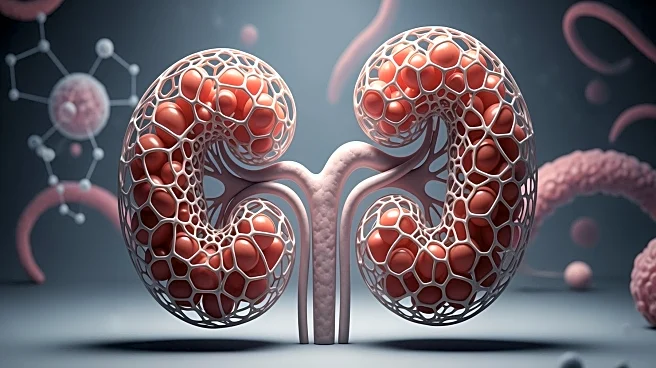What's Happening?
Recent research has explored the role of mitophagy in Drosophila Malpighian tubules, revealing its significance in kidney function and diabetic kidney disease (DKD). Using a pH-dependent reporter system,
scientists have mapped mitophagy levels in various tissues, including the Malpighian tubules, which are analogous to human kidneys. The study found that mitophagy is highly active in these tubules, suggesting a crucial role in maintaining kidney health. The research employed engineered mt-Keima, a fluorescent protein, to measure mitophagy levels, showing that mitophagy is essential for the secretory function of the tubules. The study also linked reduced mitophagy to DKD development, using a high-sugar diet model in Drosophila to simulate DKD conditions. This model demonstrated decreased mitophagy activity, increased mitochondrial dysfunction, and impaired secretion in the tubules, highlighting the potential of mitophagy as a therapeutic target for kidney-related diseases.
Why It's Important?
The findings underscore the importance of mitophagy in kidney function and its potential role in the development of diabetic kidney disease. Mitophagy, a process of mitochondrial degradation, is crucial for cellular health, particularly in high-energy-demand organs like the kidney. The research suggests that impaired mitophagy may lead to mitochondrial dysfunction, contributing to DKD. This insight opens avenues for therapeutic interventions targeting mitophagy to prevent or treat kidney diseases. The study's use of Drosophila as a model organism provides a valuable tool for understanding human kidney function and disease, offering a cost-effective and efficient method for studying complex biological processes. The potential to stimulate mitophagy as a treatment strategy could have significant implications for managing DKD and other renal conditions, potentially improving patient outcomes and reducing healthcare costs.
What's Next?
Future research may focus on developing mitophagy-specific inducers as therapeutic agents for kidney diseases. The study identified PDE701 as a promising mitophagy inducer, which successfully reversed DKD-related defects in Drosophila models. Further investigation into PDE701's mechanisms and efficacy in human cells could lead to new treatments for DKD. Additionally, exploring the role of mitophagy in other renal diseases and its interaction with various cellular pathways could provide deeper insights into kidney health. Clinical trials may be necessary to evaluate the safety and effectiveness of mitophagy-targeted therapies in humans. Researchers might also investigate the genetic and environmental factors influencing mitophagy activity, aiming to develop personalized medicine approaches for kidney disease management.
Beyond the Headlines
The study highlights the ethical and scientific importance of using model organisms like Drosophila in biomedical research. These models offer insights into human diseases while minimizing ethical concerns associated with human and mammalian studies. The research also emphasizes the need for interdisciplinary approaches, combining genetics, biochemistry, and physiology to unravel complex biological processes. Long-term, the findings could influence public health policies by promoting preventive measures and early interventions for kidney diseases. The cultural shift towards understanding and treating diseases at the cellular level may lead to more holistic healthcare approaches, integrating lifestyle changes with medical treatments.












